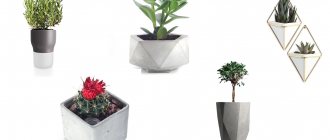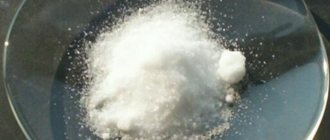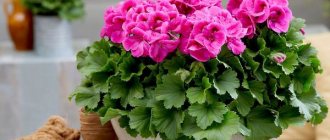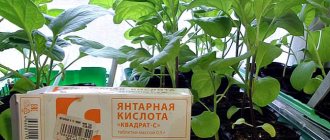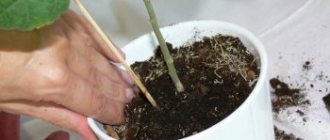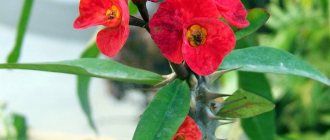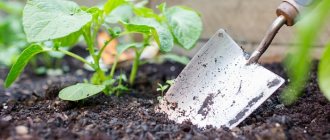Beneficial features
The main task of boron is to ensure high-quality growth and development of the flower. It stimulates metabolism, nitrogen synthesis, and chlorophyll production. As a result, the roots receive a full amount of oxygen and calcium.
Fertilizer is an active participant in the formation of new shoots, buds, and flowers. The plant acquires a powerful leaf apparatus, a healthy root system, and prepares for abundant flowering. Preventative spraying increases resistance to adverse conditions.
Important! Lack of boron provokes the development of diseases. Indoor plants suffer from bacteriosis, rot, and viral infections. An excess of the element causes necrosis, burns, and yellowing of the lower leaves.
Benefit:
- rapid germination of seeds, bulbs, cuttings;
- increasing the volume of chlorophyll, stabilizing the synthesis of phytohormones - all this ensures the growth and development of indoor plants;
- recovery after transplantation, successful rooting of “babies”;
- stimulation of the formation of new growth points, roots, shoots, flowers, ovaries;
- strengthening stems and green mass;
- stopping putrefactive, bacterial lesions;
- anti-stress, adaptation to environmental factors;
- complete absorption of calcium and oxygen by the roots.
A nicotinic acid
Nicotinic acid is needed for proper hormonal metabolism during the period of active growth. Thanks to its resuscitation actions, it is suitable for flowers that are in a declining state. Regular use of niacin will accelerate the growth of new root cells in the plant. Nicotinic acid is the familiar vitamin B3 in its pure form, and since it is practically not contained in vitamin cocktails for flowers or its concentration is low, orchids simply need this acid at least two or three times a season.
Bob is still at the peak of fashion. Ideas for fashionable and stylish bob haircuts
“Coronavirus” benefits that will be canceled in the Russian Federation on April 1 have been named
The Home Cleaning Basket and Other Simple Time-Saving Tricks
For which house flowers should I use?
The fertilizer is suitable for feeding any indoor plants. The main thing is to recognize a microelement deficiency in time.
Use for processing:
- Cyclamena (Umbrella, Lulu, Rococo, Aurora, Victoria, Green Ice, Silver).
- Orchids (Vanda, Miltonia, Cambria, Cattleya, Phalaenopsis, Oncidium, Lady's slipper, Brassia).
- Begonia (Royal, Metallica, Bauer, Mason).
- Pelargonium (Orange, Ice Rose, Iris, Mini Diana).
- Hibiscus (Copper King, Cranberry Crush, Old Yella).
- Anthuriums (Jolie pink, Zizou, Lilly, Semper, Red).
- Indoor roses (Cordana, Prima Ballerina, Curler, Hummingbird, Baby Masquerade).
- Kalanchoe (Fiery, Kalandiva, Degremona, Blossfeld).
- Violets (Zemfira, Sputnik, Austin's Smile, Melody Kimi).
- Ficusov (Benjamina, Starlight, Natasha).
Signs of boron deficiency
It is easy to diagnose a mineral deficiency - just carefully examine the flower. Most often this occurs due to an unbalanced soil composition. The plant starves in acidic soils. The reasons for a decrease in the amount of boron may be excessive watering, incorrect application of organic matter, or NPK fertilizing.
Important! Check the composition of the soil in which the flower grows. A high content of sand, lime, peat, and impaired acidity lead to a deficiency of mineral components.
Growth slowdown
Microelement deficiency can be recognized by sluggish apical shoots that turn pale due to lack of photosynthesis. They suffer especially severely, even to the point of dying. A long-term lack of boron leads to a complete cessation of growth and development.
Other signs:
- the growth point is affected, the flower begins to develop with the help of side shoots;
- the appearance of young foliage abruptly stops;
- the plant freezes due to a weak root system.
Poor condition of leaves
Boron deficiency is manifested by a change in the cellular structure, an increase in the walls of the leaf blades.
External signs:
- the top of the plant suffers, signs of chlorosis begin to appear, the color changes to light green followed by yellowing;
- degradation of the interveinal space is clearly visible;
- finely spotted mosaic bleaching is observed throughout the green mass. The veins, on the contrary, darken and may become black;
- the plates become brittle and break when bent. They curl into a horizontal tube. They often thicken, become denser, and die.
No flowering
Another symptom is deformation of the ovaries. The flowers that have already appeared fall off. The formation of new ones stops. The buds do not form at all or quickly fall off. The plant looks withered and tired.
The role of boron for the active growth and flowering of indoor plants
Boric acid for orchids: application, reviews.
Boric acid is more often used in open ground gardening as a fertilizer that replenishes the lack of the microelement boron. Well suited for indoor orchids. The useful element has important features necessary for vital processes in the life of orchids.
With the participation of boron:
- The work of nitrogen-containing substances, which are responsible for the growth of stems and leaves, is activated
- Chlorophyll synthesis occurs
- Plant metabolism is normalized,
- Budding improves, and, as a result, the quality and duration of flowering.
Due to the fact that the element takes part in strengthening plant tissues, it indirectly affects disease resistance. The smell of boric acid, which is not perceptible to humans, repels harmful insects that live in the nutrient substrate or on the leaves of orchids.
If there is not enough boron in the plant mixture, this will affect the condition of the plant:
- The roots weaken and rot, making it difficult to absorb nutrients.
- Leaves lose turgor (elasticity).
- The color of the leaf blades becomes pale.
- The likelihood of the growth point dying off increases.
- Flower buds do not form.
- The plant is easily susceptible to diseases - powdery mildew, spotting, root rot.
- A weakened orchid becomes easy prey for pests.
Specialist consultation
A lack of boron is observed in soils with a predominance of peat. If there is too much of it in the orchid substrate, then the likelihood of a deficiency of the element is almost always guaranteed.
A. P. Nenashev - Art. n. Art. fourth department of subtropical crops of the Penza Botanical Garden named after. I. I. Sprygina.
Proportions for breeding
The drug is used carefully, with maximum caution. Carefully calculate the proportions before adding boric acid. An overdose can cause the death of the flower.
Peculiarity! The product is used in liquid or granular powder form. Both variations are available in pharmacies and garden centers. It is believed that the first option is more effective.
Proportions:
- 0.2 g/l - preparation of planting material (soaking bulbs, cuttings, seeds);
- 0.5 g/l - foliar feeding (spraying);
- 1g/10 l - root feeding (introduction into the soil mixture).
Methods of application as fertilizer
Boron deficiency cannot be compensated for by one-time feeding. Fertilizers based on it are used not only in spring, but throughout the entire growing season.
Clean solution
The drug is used to treat seeds, bulbs, and cuttings of indoor plants before planting. This will increase the growth factor and the quality of young shoots. Prepare a solution at a dosage of 0.2 g/l. Dissolve the powder in water with continuous stirring. Soak the seed for 12 hours.
To enhance the effect, use a complex of microelements:
- 0.1-0.3 g boric acid;
- 0.5 g zinc sulfate;
- 1 g potassium permanganate;
- 1 g molybdenum;
- 0.5 g methylene blue;
- 0.5 g of copper sulfate.
The multimineral composition is diluted in a liter of water. The planting material must be completely immersed in the solution. When processing is completed, it is dried and planted.
Spraying
Wetting the green mass leads to abundant and long-lasting flowering. Increases resistance to diseases, pests, unfavorable and stressful growth conditions. Carry out the first wetting in the budding phase, the second - at the peak of flowering, the third - 2 weeks after it.
What to do:
- Add 5 g of powder to 10 liters of water or use a proportion of 0.5 g/1 liter.
- Pour the composition into a spray bottle and wet the sheet plates on both sides. Clean them from dust first. Irrigate foliage in the evening or on a cloudy day. Otherwise, the plant will suffer from burns.
Peculiarity! Combining boron with other microelements requires a dosage reduction of 50%.
Top dressing
Adding fertilizer to the soil is effective for flowering plants. It is carried out rarely, once every 3 years, when signs of boron deficiency are visible.
What to do:
- moisten the soil to avoid root burns;
- prepare a solution based on 10 liters of warm water and 1 g of powder. To ensure complete dissolution, first dilute the granules in hot water, then bring the amount to the specified volume;
- water the plant;
- place the pot in a sunny place - fertilizing will stimulate nitrogen production, and ultraviolet deficiency will negatively affect subsequent growth.
Don't forget to add fertilizer to the soil if you plan to plant seedlings or seeds. Water the soil with a watering can, loosen it and use it for its intended purpose.
Table 1. Regulations for introducing boron fertilizers into the soil
| Boric acid | 0.8-1.2 g/sq.m |
| Borax | 1.5-2 |
| Boric superphosphate | 2-2.5 |
| Boron-datolite fertilizer | 1.5-2 |
General recommendations for use
How to dissolve boric acid in water? Heat a small amount of liquid to 70°C and add the granules. Next, bring the solution to the desired proportion with cold water.
How to foliar fertilize with boric acid:
- Work with the substance should be carried out in the absence of rain;
- Use personal protective equipment when in contact with the chemical;
- Store the solution for no more than a day.
If fertilizer application doses are not observed, an overdose may occur. For example, if after two treatments with this element the leaf continues to turn yellow and dry out, there is no need to apply a shock dose of the chemical a third time. Find the reasons for this phenomenon. This may be a deficiency of iron, nitrogen, or care errors.
Excess boron appears on adult lower leaves. Red spots appear on them, which gradually increase in size. Over time, leaf tissues die.
This is how excess boron appears on plant leaves.
Expected effect
3-4 days after feeding, the plant comes to life. The green mass acquires a healthy, rich color. The stems become stronger. Growth and development are restored, normalized.
Boric acid unlocks the potential of flowering indoor plants. Fertilizer ensures lush and long-lasting flowering. By the end of the growing season, the flowers go into rest strong, prepared, and are less likely to suffer from pests, rot, bacterial, and viral infections. Successfully withstand adverse environmental conditions.
How boric acid works on indoor flowers
The use of boric acid has a positive effect on plants at all stages of development, namely:
- seed germination increases with the seedling method of cultivation;
- seedlings adapt faster after picking;
- growth processes are activated, flowers begin to actively branch and grow additional roots;
- The quality of flowering improves and the number of buds increases.
Boric acid is also an excellent antiseptic. It protects flowers from many diseases and increases their resistance to temperature changes.
Precautionary measures
The substance belongs to hazard class IV, which means it does not cause harm if it comes into contact with exposed skin. But powder particles can enter the body through the respiratory tract, so prepare the supplement while wearing a mask. Avoid contact of the solution with damaged skin (wounds, scratches). Make sure that children and animals do not take the acid inside. If this happens, consult a doctor immediately.
Possible harm
It is very difficult to cause damage to indoor plants when using boric acid. The product is recognized by flower growers as one of the safest.
Negative consequences of excessive feeding:
- the leaf plates are deformed and take on a dome-shaped shape;
- the roots suffer from burns (happens when fertilizer is introduced into dry soil);
- the border of leaves dries out;
- the green mass dies and falls off.
